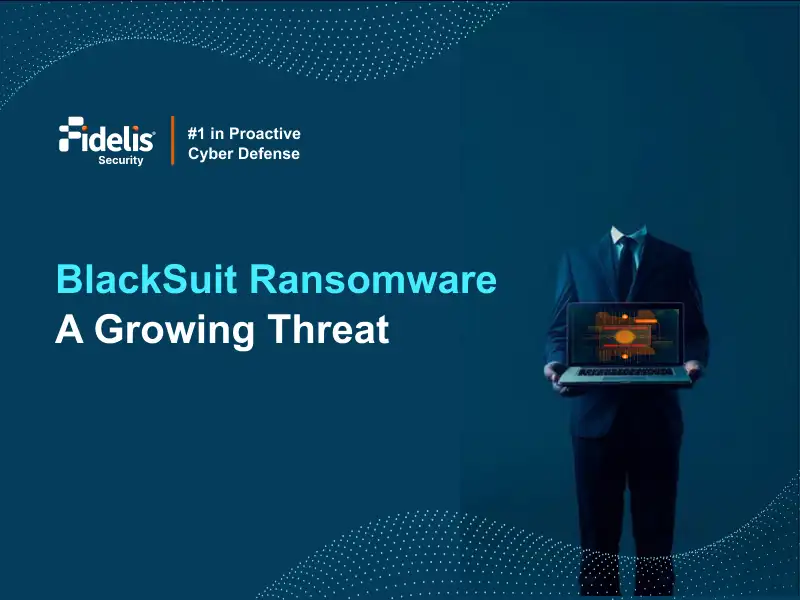Key Takeaways
- Rootkits are highly secretive, meaning prevention is more effective than remediation.
- Building layers of defense, in terms of access control, patching, and visibility are necessary to prevent a rootkit attack.
- Regular monitoring and user education will be critical for long term prevention of rootkits.
A rootkit is a set of malicious software that allows unauthorized and privileged access to a computer or network under concealment and is identified as malware. A rootkit installs itself low in the operating system or firmware in a way that allows it to hide itself, most commonly at the expense of security tools. Rootkits hijack low-level processes, and system calls to allow the attacker to retain control over a machine without the owner being aware of it. Rootkits are defined as “running software on a computer…that is not currently permitted” and disguise themselves or additional malware. In practical use, a rootkit can install a backdoor, keylogger, or other malicious payloads without being detected.
What Is a Rootkit and How Does It Work?
Here’s what really happens: when your OS asks for information — like a list of running processes or files — the rootkit quietly steps in, hides its presence, and gives back a clean result. That’s how it avoids being noticed.
Some rootkits are categorized as user-mode rootkits because they hijack and run malicious code inside an otherwise legitimate program or system processes. Others are kernel-mode rootkits, which run at kernel level and have the same privileges as the OS itself. Kernel-mode rootkits can change fundamental data about what is part of the OS, disable security software, halt logging processes (to hide evidence), and other activities. The most dangerous types of rootkits function even earlier, or lower, than the OS by hijacking and replacing the boot loader, infecting firmware, or running at the hypervisor level. These rootkits can survive a system reinstall and have control of the system during the boot process before the OS comes online.
Rootkits fundamentally change system behavior at a very low level, which includes hiding the files they are injecting, changing process behavior, and altering startup code – all in the name of maintaining stealthy, persistent access to your system as long as possible.
What Are the Different Types of Rootkits?
Rootkits can hide in different parts of your system. Understanding where they live helps you plan how to defend against them.
Here are the main types:
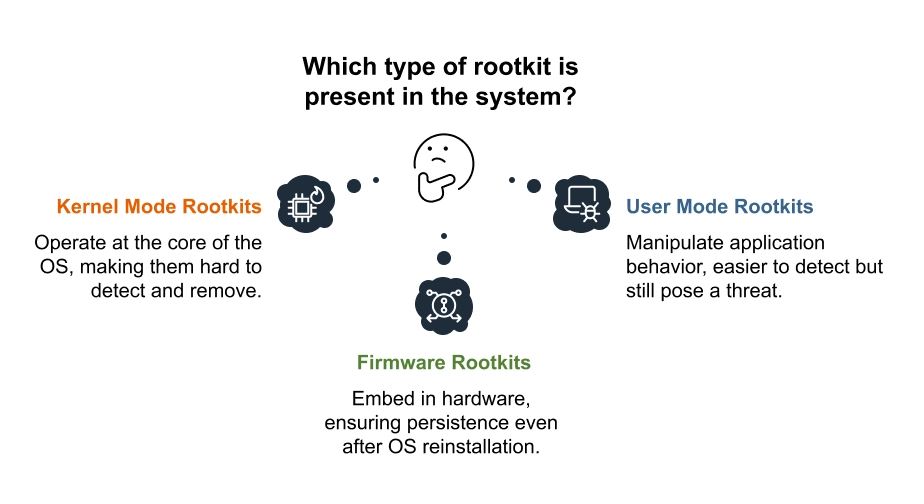
- User-mode rootkits:
These run at the same level as regular programs. They often inject malicious code into applications or intercept system calls in memory. Because they don’t modify the operating system directly, they’re easier to detect and remove compared to kernel-level ones. - Kernel-mode rootkits:
These run with full system privileges, just like your operating system’s core. They can replace or modify kernel modules and drivers, making them extremely powerful and hard to remove. They’re capable of hiding files, processes, or even disabling your endpoint protection. - Bootkits:
Bootkits infect your system before it even starts up — by modifying the bootloader or master boot record (MBR). Since they load before your OS, they can hide from most security tools and persist even after you reinstall the operating system. - Firmware or hardware rootkits:
These live in device firmware, such as BIOS or UEFI chips, network cards, or hard drives. They are among the hardest to find because firmware isn’t checked often. Even replacing or reinstalling your OS won’t remove them. - Hypervisor-based rootkits:
These run underneath your operating system as a malicious hypervisor. By doing so, they can monitor and control your system from below, without modifying the OS itself. While rare, this type shows how far attackers can go to stay hidden.
Evolution of Rootkits
The evolution of rootkits can be summarized as follows:
- Initially, rootkits were legitimate administrative tools designed to provide authorized users with root-level access to computer systems.
- In 1990, the first malicious rootkits appeared, targeting unix system to conceal intruders’ activities while gaining root access.
- In 1999, rootkits started targeting Windows systems, shifting to more widely used operating systems and revealing their potential for misuse.
Over time, rootkits have evolved significantly, employing sophisticated techniques to modify operating system functions and hide their presence. Modern rootkits are serious threats, capable of manipulating system files, processes, and hardware components to evade detection.
- Maturing Advanced Threat Defense
- 4 Must-Do's for Advanced Threat Defense
- Automating Detection and Response

How Rootkits Work
Rootkits can be installed through various methods, including exploiting software vulnerabilities and using infected USB drives. Attackers may utilize blended threats by combining a rootkit with a dropper and a loader to exploit vulnerabilities and gain access to a system. Once installed, rootkits can deactivate antimalware and antivirus software, complicating detection.
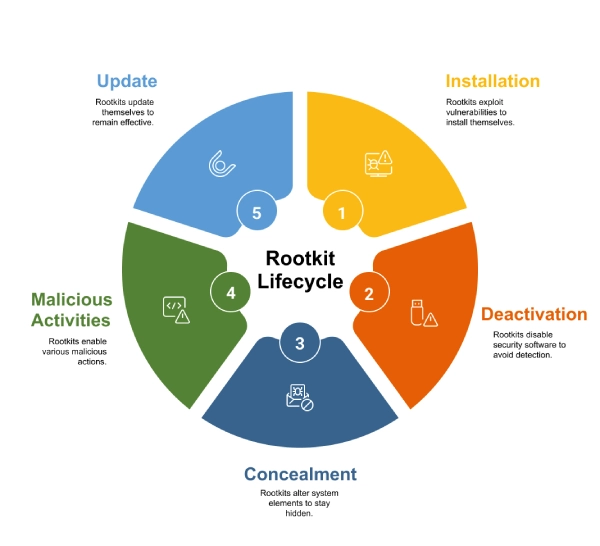
Rootkits alter files, processes, and memory to remain undetected. They intercept system calls to disguise malicious actions and stay undetected for extended periods. Modern rootkits often conceal other forms of malware, enabling attackers to carry out various malicious activities without detection. Effective rootkit protection is essential to safeguard systems from these threats.
Specific tasks and tools delivered by rootkits can include banking credential stealers, antivirus disablers, and local update capabilities to ensure they remain functional and updated. This versatility makes rootkits a formidable threat to any computer system.
How Are Rootkits Detected and Removed?
To uncover hidden rootkits and restore system integrity consider the following:
- Use behavioral or anomaly analysis: Continuously monitor your system for unusual activity such as hidden processes, abnormal system privilege escalations, or unauthorized kernel modifications.
- Perform system integrity checks: System files, file configurations, and registry keys should be checked regularly against a trusted, well-good baseline to detect unauthorized or unintended alterations.
- Use memory forensics: Collect and analyze volatile memory (random-access memory or RAM) to potentially detect injected code or hidden modules that may not be evident through drive scans.
- Use out-of-band scanning: Diagnostic scans should occur from a trusted, uncompromised environment outside of the operating system that may be affected, to identify malicious files or hidden drivers.
- Monitor system traffic: Detect any stealthy command-and-control / C2 communication as well as any suspicious outgoing message or message loop to parse for rootkit-associated communications.
- Build behavior baselines: Everything that is normal should have a defined baseline in systems and networks so that an alert is generated automatically on the events that deviate from previously learned normal activity; the more data, the better.
- Rebuild as needed: Once it is confirmed that a system has been compromised at the deep-level, isolate that host, preserve requisite forensic data, and perform a complete remanufacturing or system restoration, from a known-good source, instead of attempted cleaning of a system.
By using multiple overlaying methods, organizations can increase rootkit detection success and improve response efforts.
How Can Organizations Prevent Rootkit Infections?
To strengthen resilience against rootkit attacks, consider the following:
- Strive for strong access controls: Enforce minimum necessary privileges to reduce the risk of unauthorized users or attack code gaining root-like access.
- Harden system configurations: Turn off unused services, restrict kernel level access, and allow only signed drivers and known bootloaders to start. This often helps block kernel and bootloader rootkits before they load.
- Implement timely patches and firmware updates: You need to keep operating systems, applications, and device firmware up to date, as many rootkits use unpatched vulnerabilities at the kernel or driver levels.
- Consider the use of secure boot or hardware-based protections: You have to make sure that all your systems should use UEFI Secure Boot, a hardware root of trust, or virtualization-based security features to prevent tampering at the firmware or hypervisor layer.
- Strengthen endpoint and network visibility: Your security teams need to establish advanced detection and response tools that monitor system behavior in real-time, identify hidden persistence mechanisms, and isolate hotspots before the damage expands.
- Train users and administrators: Yiu need to provide users and or system administrators with awareness training on phishing, malicious downloads, and hygiene concerning removable media, all common methods for a rootkit delivery.
- Have secure, verified backups and recovery plans: You have to make sure that your critical systems and data need to be protected with encrypted, offline backups, in case a secure environment needs to be recreated.
By following these prevention tips and best practices, organizations can dramatically lower the chance that a rootkit will take hold. Fidelis’s security experts stress that a proactive stance – patch management, strict privilege controls, and continuous monitoring – is the most effective defense against rootkit threats. When combined with robust detection and incident response plans, these measures form a comprehensive strategy for guarding against one of cybersecurity’s most covert threats.
Best Practices for Rootkit Defense
Preventing rootkits involves:
- User education and awareness.
- Training on detecting malicious links, email attachments, and phishing attempts.
- Regular software updates.
- Network traffic monitoring.
- Endpoint detection solutions.
Least privilege principles limit the number of users with administrative rights, reducing the chances of rootkit installation. Regular system integrity checks help identify unauthorized changes that may indicate a compromised system or a rootkit infection.
Famous Rootkit Attacks
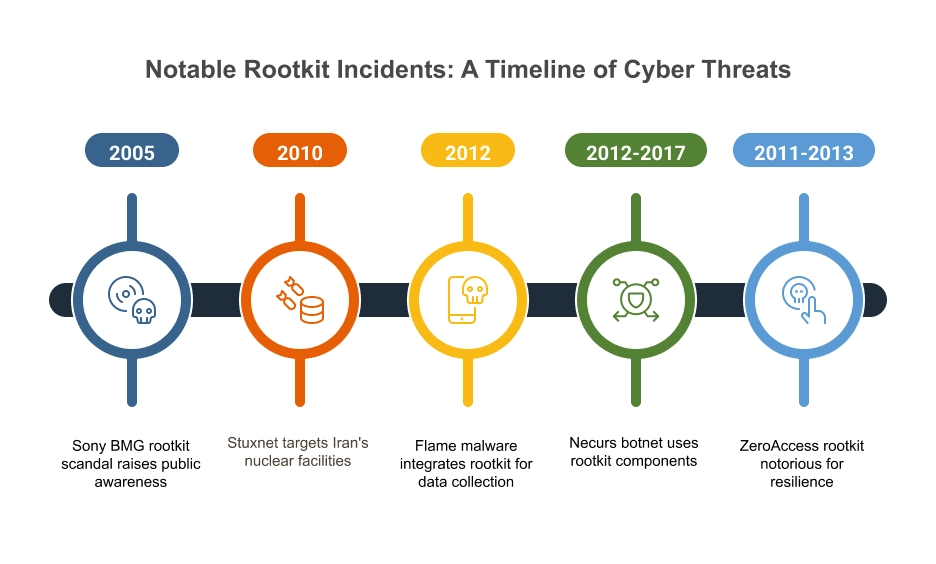
The Sony BMG rootkit scandal in 2005 raised public awareness about the risks associated with rootkits. Deployment of rootkits on over 25 million CDs for digital rights management led to a public scandal, revealing how DRM measures left users vulnerable to attacks.
Stuxnet, identified in 2010, utilized rootkit technology to evade detection while targeting Iran’s nuclear facilities. Similarly, Flame malware and other malware, discovered in 2012, integrated a rootkit for covert data collection in the Middle East.
The Necurs botnet, active from 2012 to 2017, employed rootkit components to maintain its massive network despite efforts to dismantle it. Meanwhile, the ZeroAccess rootkit, operating between 2011 and 2013, was notorious for its resilience against removal and its role in click fraud and Bitcoin mining.
Fidelis Security Solutions Against Rootkit
Fidelis Elevate® XDR provides integrated security across endpoints, networks, and cloud environments for comprehensive defense against rootkit threats. The platform utilizes automation to respond to incidents by isolating compromised assets, increasing the efficiency of security teams.
Fidelis employs deception technology and MITRE ATT&CK mappings to enhance threat detection and response capabilities. These advanced features make Fidelis Elevate® XDR a robust solution for protecting against rootkits and other sophisticated threats.
- Detect and Correlate Weak Signals
- Active Threat Detection
- Evaluate Findings Against Known Attack Vectors
- Proactively Secure Systems
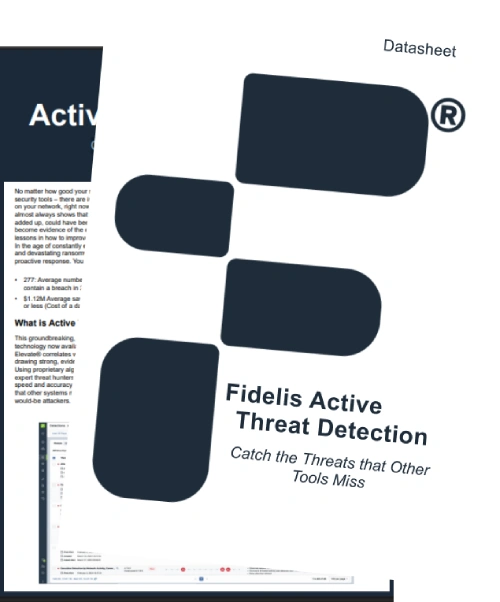
Summary
Rootkits represent a significant threat to modern computer systems, with their ability to evade detection and perform malicious activities. Understanding the different types of rootkits, how they work, and the methods for detecting and protecting against them is crucial for maintaining system integrity.
By staying vigilant, employing advanced security solutions, and adhering to best practices for rootkit defense, you can protect your systems from these hidden threats. Remember, the key to defeating rootkits lies in a proactive and comprehensive cybersecurity strategy.
Frequently Ask Questions
Why is it called rootkit?
The term “rootkit” comes from “root” (admin-level access in Unix/Linux systems) and “kit” (a set of software tools). Together, it refers to a toolset that gives attackers unauthorized root-level access while hiding their activities from detection.
What is the difference between a virus and a rootkit?
A virus is a type of malware that replicates itself and spreads to other files or systems, typically damaging data or disrupting operations. A rootkit, on the other hand, is designed to hide the existence of malicious processes or software and provide persistent, stealthy access to the system. While a virus spreads, a rootkit conceals.
How are rootkits typically installed on a system?
Rootkits are typically installed by exploiting software vulnerabilities, using infected USB drives, or through blended threats such as droppers and loaders. It is crucial to maintain robust security measures to prevent such installations.
How can I protect my system against rootkits?
To effectively protect your system against rootkits, it is essential to implement regular software updates, provide security awareness training, enforce strict access controls, and utilize advanced endpoint detection tools. These strategies will significantly enhance your system’s defenses.
What should I do if I suspect a rootkit infection?
If you suspect a rootkit infection, it is essential to use multiple scanners and rootkit removal tools while booting your computer into Safe Mode. Additionally, consider reinstalling the operating system or restoring from backups to completely eliminate the threat.

